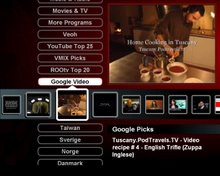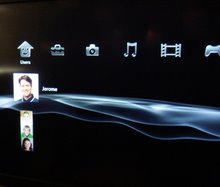The Issue: The avalanche of “Internet-enabled STB” announcements shows no signs of abating anytime soon. Given the number of detractors let alone prior failures, what continues to compel their advocates?
Behind the scene: No widely accepted standard for TV-based Internet video browsing has yet emerged. Clearly, it makes sense to enlist game platforms -- many of which are already connected to the Internet -- to the task of video browsing. But what can be learned from such efforts, regarding the task of enabling Internet browsing for TVs in general?
Solution: After all else has been tried, it seems likely that the forces of ‘lowest cost’, ‘simplest maintenance’, ‘longest useful life’, ‘unrestricted operation’, ‘easiest installation’, ‘minimum development complexity’ and ‘most user features’ will decide what hardware will be used for Internet video browsing at the TV. Active-TV technology is well placed for a decision based on these criteria.
Blockbuster, Vudu, Netflix, TiVo, Apple TV, BuildingB are some of the better known US companies introducing a Set-Top Box (STB) to enable TV access to their Internet-delivered video. There are many lesser-known units, such as the Myka, which bring BitTorrent directly to a box connected to the TV. (The 80 GB-version Myka 80 costs $299 and the 500 GB-version costs $459 -- typical prices for such boxes.) The Apple TV at $229 is said to make little profit. One of the lowest cost media adapter boxes is the D-Link DSM-520, currently selling for $150 at Circuit City.
Why so many boxes? The answer lies in an Internet video broadcaster’s requirement for a box to support a “please use my portal!” strategy. With few exceptions, notably the D-Link DSM-520, these boxes do not support open Internet video browsing. Rather, they are the hardware underpinning for a “walled garden” approach, one that delivers video from the broadcaster’s video library to the TV watcher. The fact that all prior Internet-STB projects with similar business models have failed does not deter repeated optimism for releasing new hardware.
Home users in the US have shown significant reluctance to purchase of any new STB – even the easy-to-use Apple TV. The idea that a user may require one STB per Internet broadcaster seems less than practical. But the business models on trial are driven by a common ambition to be a dominant video supplier or ‘video aggregator’ with a single STB that everyone uses; to be sure, a bit like Apple’s hope that the Apple TV would be the “DVD player for the Internet age”.
Why a STB and not the TV
Closed portal strategies are tied to STB use. This is because integration of Internet browsing directly into TVs has even less appeal because TV buyers are least likely to buy a TV which can only ‘tune’ to a single Internet broadcaster. The latest generation TV system-on-a-chip (SOC) devices with networking support make it technically possible to integrate access to one of today’s portal services, but it is far from clear how the TV’s support firmware can be maintained over a TV’s expected lifespan (6 – 10 years).
A relatively easy and certainly inexpensive way to give a TV access to Internet video is to use a PC-assisted approach, such as active-TV technology. Once such a system is installed at home, it enables the TV to use the latest Web 2.0 methods to freely browse any video broadcaster’s TV-websites. Notwithstanding clear advantages, some new developers still ask me how to get rid of the PC from the system. I am familiar with the methods of achieving this. But they come with significant tradeoffs…
From both the buyer and manufacturer points of view, it is important not to add to the cost of the TV; and equally important not to add software maintenance issues to the TV. It is also important not to limit the useful life of the TV. Also, the TV UI must be sufficiently responsive to keep pace with both the requirements and expectations of users familiar with PC Web 2.0 technology. Moreover, it is important to ensure the TV will be able to browse new Internet video broadcaster sites for years to come. Can all of this be achieved if the PC-assist approach is replaced with new integrated-TV technology? Needless to say, these requirements result in conflicts.
Making the TV smart enough
The non-PC-assist approach is to embed a small browser engine into the TV. This adds some cost and complexity to the TV. The closer to full Web 2.0 support required, the greater the cost and complexity entailed. Additionally, Web 2.0 keeps developing, such that the "chase" never ends. Leaders in developing these small embedded browsers are Oregan Networks and Opera.
Despite the failure of Intel Viiv and AMD LIVE! to gain a significant ‘hold’ of the living room TV, Intel and AMD nevertheless have development projects, Kenmore and Bobcat respectively, to integrate a lower power x86 cores into a TV SOC. This is an old idea, based on the understanding that the necessary support software is more available for x86 than the types of core processors used in, say, TV SOCs from Sigma Designs or ST Micro. Will TV users demand browser support features which leave non-x86 TV chips at a disadvantage? Will even the embedded x86 TV chips be able to satisfy users familiar with the latest Web 2.0 features available on their PCs? The unassisted TV approach likely has some user appeal, but once a TV is connected into the home network, it is very easy for it to be without any competitive disadvantage in terms of video browsing support – the TV just has to ‘wake up’ a networked PC and put its browser on proxy duty.
Most of “ultimate Internet aggregation” STB or digital media adapter projects (including Apple TV) are based on x86 because of the software development problems. So far, potential buyers have indicated the resulting cost increase is too much. Printers, DVD players, hard disc recorders, home wireless networking and other peripheral devices, are best not built into the TV. Maybe Web 2.0 support (if that is what is required) should also not be built into the TV?
TV developers have told me it adds zero hardware cost to include active-TV technology with a new networked TV. The PC is a good peer-to-peer or BitTorrent engine. Torrent support can be relatively complex for direct integration into low-cost TVs. I can see that for some implementations it may be useful to have a TV torrent box such as the Myka, but how many consumers will think it worth more than $300 when there are zero-cost TV-websites with complete torrent download control available? Via these TV-websites and the home network, the TV can ask for PC-assistance in managing the torrent on its behalf.
Reaching a TV audience
Recently announced are the Adobe Media Player and Adobe TV, a video aggregation website which is brand skinable and has advertising support. Adobe says, “In a (technical) nutshell, Adobe Media Player is an RSS aggregator. It consumes standard Media RSS feeds to notify and deliver video content to users.” The RSS mashing part sounds a bit like TVersity or Orb.
While the Adobe Media Player is described as skinable, this does not extend its capabilities to supporting a TV-formatted website, where navigation is via the TV IR remote rather than a desktop mouse. The Adobe Media Payer may be billed as a “cross-platform desktop player”, but it does not appear intended to work with a small browser embedded into a TV or STB – Adobe is not (yet) trying to reach a living room TV audience. Their technology relies on the more extensive PC support features (Web 2.0) to perform its media-oriented UI and RSS aggregation services.
One company trying to bridge the divide and reach a living room audience is the BBC, which has launched Nintendo Wii support for its iPlayer TV catch-up site. Game platforms, such as the Wii and Sony Playstation, support small Internet browsers. This does not allow them to access typical PC-websites such as www.youtube.com, since these sites make use of too much Web 2.0 technology or methods for the small browser to handle (Opera -- in the Wii case). The Wii can access websites which have reduced complexity and are tailored for the Wii – I think Nintendo calls them ‘Internet Channels’.
Maybe this is the future of Internet video browsing – the establishment of some simpler-formatted TV-website standard? However, there is also push to add widget support and social networking to TV-websites which conflicts with broad adoption of simpler standards. In any case, it is easy to see how the task of adding TV-website support into TVs will stretch TV developers – and they typically have less software development skills than game platform developers. In contrast, the active-TV technology approach results in relatively easy engineering tasks.
To dwell on the Wii’s Opera browser a little longer, it does not support the latest Flash video formats or permit access to video utilizing advanced encoding -- a big restriction to extensive browsing hopes. To get the iPlayer to work with the Wii the BBC has to re-encode its video library in the older Flash 7 format. Separately, Scendix Software, known for its development in MCE TV-web applications is also now retargeting some of its applications to the Wii. These carefully crafted projects will bring an audience to the Wii, but it is not clear if it will provide anytime soon a broadly accepted integrated-TV solution to Internet video browsing...
Escaping the PC?
On the BBC blog, I read Anthony Rose’s (head of digital media technology) comments: “Today, most people watch iPlayer programmes on their computer. That's great - you can watch your favourite BBC programmes curled up in bed with your notebook PC”. He goes on to suggest that it is easier to connect the Wii to the TV than a PC to the TV. This of course is true. But the harder task is connecting anything to the home network.
Any video browsing device must be connected to the home network, be it a Nintendo Wii, a networked-STB, or an active-TV technology-enabled TV. This is proving the hardest task for the home installer who typically prefers to use a wireless network rather than a high-speed wired connection. The option to utilize PC-assist is largely irrelevant to the complexities of this installation task. With few exceptions, a person installing a video browsing platform has already connected a PC or notebook computer to their home network – this is the path taken to reach any broadband service. Any network-enabled TV, therefore, is in a position to access personal media stored on other devices within the home network, including a PC. Given the existing reliance on the home network and attached PC, why not also ‘borrow’ the PC’s browser to help the TV with some Web 2.0 video browsing, in a way most likely invisible to the PC user?
In so doing, you can curl up in bed and watch Internet video on your new active-TV enabled TV (rather than the notebook PC), without ever thinking about TV browser upgrades or browser obsolesce. In other words, you can think of the PC-assist approach as similar to attaching a networked printer to the TV. The TV can be used without a ‘printer’, but it is sometimes useful to have it attached (for example, in the case of the attached PC, when Internet video browsing). In other words, the TV works without the networked PC, but when available, the TV can do so much. Best of all, this is accomplished without adding any hardware cost to the networked TV.
The market has not yet decided which approach is the "correct" solution. What portion of the market will use PC-assist? What portion will use an embedded STB browser? Will STB buyers accept ‘walled garden’ portals or demand open Internet browsing? To be sure, the PC-assist approach solves many problems for the TV supplier: it affords the lowest cost, provides for ‘tuning’ to any Internet video broadcast, and ensures the longest TV life – these seem like pretty compelling arguments to me.
Feedback, corrections and comments welcome. Contact me for more information or support with active-TV technology development.
Daniel Mann
Navigate YouTube available at iTunes App Sore
An easy to use iPhone and iPod touch App that enables both new and advanced YouTube users to get the best from YouTube.
Browse video Standard Feeds, Categories, Channels and Playlists. Then organize new videos into your own favorites and playlists. Make playlists private or public. Subscribe to other user's playlists and video collections for future viewing. Subscribe to videos matching search-words.
Look at publicly viewable favorite videos, playlists and subscriptions based on your YouTube friends, family and contacts. Send and receive video links with YouTube contacts via YouTube video messages.
Search for new videos tagged for your language or geographical region, using local keyboard. Explore for new videos via easy switching of user ID to the owner of interesting videos - then explore their world.
All actions are kept in sync with PC, Mac or Apple-TV access to YouTube. Available at Apple App Store.
Browse video Standard Feeds, Categories, Channels and Playlists. Then organize new videos into your own favorites and playlists. Make playlists private or public. Subscribe to other user's playlists and video collections for future viewing. Subscribe to videos matching search-words.
Search for new videos tagged for your language or geographical region, using local keyboard. Explore for new videos via easy switching of user ID to the owner of interesting videos - then explore their world.
All actions are kept in sync with PC, Mac or Apple-TV access to YouTube. Available at Apple App Store.
active-TV technology for PC

Windows PC based home network
Subscribe to:
Post Comments (Atom)










11 comments:
So how about an Active-TV channel on the Nintendo Wii?
If you want a good site to watch tv online for free visit http://www.tvweb360.com. You don't need to download anything and it's easy to use with lots of channels.
порно студенток http://free-3x.com/ домашнее видео студентов free-3x.com/ порно видео маленькие девочки [url=http://free-3x.com/]free-3x.com[/url]
1 бесплатное порно видео
г нижневартовск секс
секс страсти
порно маленькие письки
скачать порно видео клипы бесплатно
порно секс снимки
kim kardashian sex
секс веб камеры adult
penthouse журнал фото
sex warez org
The internet TV for PC or Online TV in your computer you need to stress your mind in installation process. Your computer just needs to be equipped with Satellite TV for PC. You can do away with the monthly subscription and the cumbersome work of satellite setups which require often checkups and maintenance.
I apologise, but, in my opinion, you are not right. I am assured. Let's discuss it.
Excuse, that I interrupt you, but, in my opinion, this theme is not so actual.
Hello. And Bye.
Да уж По моему мнению об этом пишут уже на каждом заборе :)
Отправила первый пост, а он не опубликовался. Пишу второй. Это я, туристка африканских стран
great to meet you active-tv.blogspot.com blogger found your blog via Google but it was hard to find and I see you could have more visitors because there are not so many comments yet. I have discovered website which offer to dramatically increase traffic to your blog http://mass-backlinks.com they claim they managed to get close to 4000 visitors/day using their services you could also get lot more targeted traffic from search engines as you have now. I used their services and got significantly more visitors to my website. Hope this helps :) They offer most cost effective services to increase website traffic at this website http://mass-backlinks.com
Post a Comment